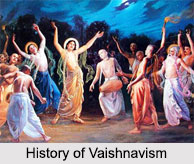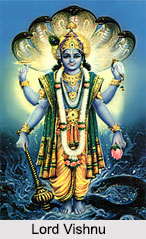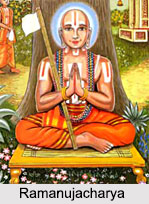 History of Vaishnavism in India can be traced right back to the Vedic period. It is one of the oldest living religions of India and the basis of the religious beliefs of Vaishnavism is the upholding of Lord Vishnu as the Ultimate Reality. It is a monotheistic system which believes that the exclusive and devoted worship of Lord Vishnu leads to the realization of the highest spiritual goal and for this purpose, it has laid down an ethical and religious discipline. The various beliefs and concepts associated with Vaishnavism are based to a great part on the Upanishads, and they are found scattered all over the various important historical documents written down the ages such as the Vedas and the Puranic texts and epics.
History of Vaishnavism in India can be traced right back to the Vedic period. It is one of the oldest living religions of India and the basis of the religious beliefs of Vaishnavism is the upholding of Lord Vishnu as the Ultimate Reality. It is a monotheistic system which believes that the exclusive and devoted worship of Lord Vishnu leads to the realization of the highest spiritual goal and for this purpose, it has laid down an ethical and religious discipline. The various beliefs and concepts associated with Vaishnavism are based to a great part on the Upanishads, and they are found scattered all over the various important historical documents written down the ages such as the Vedas and the Puranic texts and epics.
Origin of Vaishnavism
The origin of Vaishnavism can be traced back to the verbal teachings imparted by Vishnu himself to Goddess Laxmi and in turn to Visvaksena, the divine angel. The earliest known origin of Vaishnavism can be traced back to the Rig Veda, the oldest religious literature of the world. There are a number of hymns in the Rig Veda which are also repeated in the Yajur Veda and Sama Veda, which speak of Lord Vishnu as the highest personal God, who is the sole creator and controller of the universe and the saviour of humanity.
Vaishnavism in Ancient Hindu Texts
Vaishnavism is contained, discussed, elaborated and developed in a number of ancient Hindu texts. These include the Upanishads, the Puranas, the Agamas and the epics of the Mahabharata and the Ramayana.
 Upanishads: The various philosophical and religious doctrines which constitute the chief basis of Vaishnavism are found in the Upanishads in great detail. The basic themes of Ishwar (God), chitta (soul) and acit (matter), the nature of Ishwar as a personal God endowed with attributes, the Bhakti or Upasana as a sadhana or means of God-realization and the nature of Moksha as conceived in Vaishnavism are all taken from the Upanisadic teachings. The Katha Upanishad and the Shakta Upanishad hold Vishnu as the supreme deity. The Taittiriya Upanishad asserts that the Purusa who has been spoken about in the Rig Veda is the ruler of the Universe, Narayana.
Upanishads: The various philosophical and religious doctrines which constitute the chief basis of Vaishnavism are found in the Upanishads in great detail. The basic themes of Ishwar (God), chitta (soul) and acit (matter), the nature of Ishwar as a personal God endowed with attributes, the Bhakti or Upasana as a sadhana or means of God-realization and the nature of Moksha as conceived in Vaishnavism are all taken from the Upanisadic teachings. The Katha Upanishad and the Shakta Upanishad hold Vishnu as the supreme deity. The Taittiriya Upanishad asserts that the Purusa who has been spoken about in the Rig Veda is the ruler of the Universe, Narayana.
Agamas: In the period of time following the Vedas, the various important tenets of Vaishnavism have been more elaborately expounded in the Agamas. The Vaishnava Agamas uphold the exclusive worship of Vishnu as the Supreme Deity. It emphasized on the exclusive worship of Vishnu as a means of salvation. The Agamas have evolved the concept of worshipping it in an image form. As a follow up of this form of worship, the consecration of icons, the construction of temples for this purpose and the observance of certain prescribed daily rituals and other festivals in the temples have all been formulated in the Agamas.
Epics: Following the Agamas, the development of Vaishnavism has taken place in a comprehensive way in the great Indian epics of the Mahabharata and the Ramayana. The Ramayana is regarded by the Vaishnavites as a text expounding the doctrine of self-surrender. In the Mahabharata, Vishnu is identified with Narayana, Vasudeva, Bhagawan and Krishna. The importance of devoted worship to Lord Vishnu in order to attain Moksha is clearly brought out in the Mahabharata. The supremacy of Vishnu as against all other deities including Shiva and Brahma is upheld throughout the Mahabharata.
Puranas: The contribution of the Indian Puranas in general and Vishnu Purana of Sage Parasara in particular is significant in developing the Vaishnava doctrines. The Vishnu Purana is acknowledged as the oldest and the most authoritative Purana. It presents all the basic doctrines, both philosophical and theological, of Vaishnavism. It is clearly stated at the very beginning that Lord Vishnu is the main cause of creation, sustenance and dissolution of the universe. The Vaishnava concept of Paramapada is also referred to in this Purana. The Sattvika Puranas are those which emphasise the greatness of Vishnu.
Bhakti Movement and Contribution of Vaishnava Religious Leaders
Vaishnavism was greatly revived during the Bhakti movement. The Vaishnava religion has been prevalent right from the Vedic period. During this entire period of time, a number of other philosophical and religious schools of thought had come up. Thus there was a lot of opposition to Vaishnavism especially from Buddhism, Jainism and Shaivism. In order to uphold the teachings of Vaishnavism against other emerging religious philosophies there was felt the need to consolidate and systematise the thoughts found in different religious works. This task was fulfilled to a large extent by Ramanuja and his forerunners, Nathamuni and Yamunacharya.
 Nathamuni made a significant contribution to Vaishnavism by rediscovering the 4000 hymns of the Alvars, rearranging them into four parts and introducing its recitation by the Vaishnavas as part of the worship at temples. The works of Yamunacharya have laid the foundation for the formulation of the important doctrines of Vaishnavism. The most significant contribution in the development and propagation of Vaishnavism was made by Ramanuja. He did this by means of his many written works as well as propagation through the apostles. Ramanuja presents the fundamental philosophical doctrines of Visistadvaita Vedanta on the basis of the interpretation of the Vedanta Sutras.
Nathamuni made a significant contribution to Vaishnavism by rediscovering the 4000 hymns of the Alvars, rearranging them into four parts and introducing its recitation by the Vaishnavas as part of the worship at temples. The works of Yamunacharya have laid the foundation for the formulation of the important doctrines of Vaishnavism. The most significant contribution in the development and propagation of Vaishnavism was made by Ramanuja. He did this by means of his many written works as well as propagation through the apostles. Ramanuja presents the fundamental philosophical doctrines of Visistadvaita Vedanta on the basis of the interpretation of the Vedanta Sutras.
Development of Vaishnava Schools
There are four main Sampradayas within Vaishnavism. Each of these is slightly different from the other in their philosophical beliefs. Though the core of their essential beliefs is the same, each of the sampradayas has a separate understanding of the relationship between the soul (jiva) and God (Vishnu or Krishna).
Vaishnavism today has a large number of followers. The influence of Vaishnavism however has not just remained confined in the country but spread abroad as well. This has been made possible through the works of the Hare Krishna Movement. Thus, Vaishnavism has emerged as one of the strongest branches of Hinduism with the constant flow of its development right down the ages.









